Solution Manual for Fitzgerald and Kingsleys Electric Machinery 7th Edition by Umans ISBN 0073380466
9780073380469
Full link download: Solution Manual:
https://testbankpack.com/p/solution-manual-for-fitzgerald-and-kingsleys-electricmachinery-7th-edition-by-umans-isbn-0073380466-9780073380469/
Chapter 1
1 g µ µ A
Part (a): R = lc = lc = 0 A/Wb c µA c µ µ A r0 c g Rg = µ A = 5.457 × 106 A/Wb 0 c Part (b): NI 5 Φ = R c+ R = 2.437 × 10 Wb Part (c): λ = NΦ = 2.315 × 10 3 Wb Part (d): λ L = =1.654 mH I Problem 1-2 Part (a): lc Rc = µA = lc =2.419 × 105 A/Wb c r0 c 0g c
2 Rg = µ A
3 = 5.457 × 106 A/Wb
3 Part (b): Φ = NI Rc+ Rg = 2.334 ×10 5 Wb Part (c): λ = NΦ = 2 217 × 10 3 Wb Part (d): Problem 1-3 Part (a): λ L = =1.584 mH I s N = Lg µ0Ac = 287 turns Part (b): I = Bcore µ0N/g = 7.68 A Problem 1-4 Part (a): s N = L(g + lcµ0/µ) = µ0Ac s L(g + lcµ0/(µrµ0)) = 129 turns µ0Ac
4
(b): I = Bcore µ0N/(g + lcµ0/µ) = 20.78 A
Part
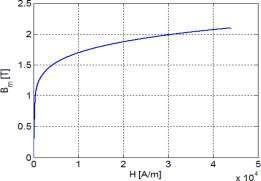

5 Problem 1-5 Part (a): Part (b): Bg = Bm = 2.1 T For Bm = 2.1 T, µr = 37.88 and thus I = Bm µ0N g + lc µr = 158 A Part (c): Problem 1-6 Part (a): µ0NI
6 B g = 2 g
Part (b): Will assume lc is “large” and lp is relatively “small”. Thus,
We can also write
These equations can be combined to give
Problem 1-7
From Problem 1-6, the inductance can be found as







7 µ µ µ µ µ Ag = µ0NI 1 − x Bc = Bg Ac 2g X0
BgAg = BpAg = BcAc
2gHg+ Hplp + Hclc = NI; and Bg = µ0Hg; Bp = µHp Bc = µHc
B = µ0NI µ0NI µ g µ µ Ag = µ x 2g + 0 lp + 0 Ac lc 2g + 0 lp + 0 1 X0 lc and Bc = x 1 X0 Bg
L = NAcBc = µ0N 2Ac I 2g + µ0 (lp + (1 x/X 0 )cl )
8
from which we can solve for µr
9 µr = µ = L lp + (1 x/X0) lc = 88 5 Problem 1-8 Part (a): µ0 µ0N 2Ac 2gL L = µ0(2N)2Ac 2g and thus N = 0.5 s 2gL Ac = 38.8 which rounds to N = 39 turns for which L = 12.33 mH. Part (b): g = 0.121 cm Part(c): Bc = Bg = 2µ0NI 2g and thus I = Bcg µ0N = 37.1 A Problem 1-9 Part (a):
10 L = µ0N 2Ac 2 g
and thus
which rounds to N = 78 turns for which
Part (b): g = 0.121
Part(c):
and thus
and thus
which rounds to N = 39 turns for which L = 12.33 mH.
Part (b): g = 0.121 cm
11
s 2gL Ac = 77.6
L
= 12.33 mH.
cm
Bc = Bg = µ0(2N)(I/2) 2g
I = 2Bcg = 37 1 A µ0N
Problem 1-10
L = µ0(2N)2Ac 2(g + ( µ0 )l ) µ c
Part (a):
uv µ0 N = 0. u2(g +( µ )lc)L = 38.8 5t Ac
N =
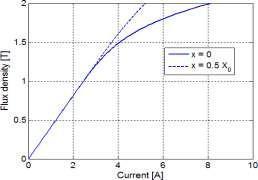
12 µ0 Part(c): Bc = Bg = 2µ0NI 2(g + µ0 l 0) µ c and thus Bc(g + µ0 lc) I = µ = 40 9 A µ0N Problem 1-11 Part (a): From the solution to Problem 1-6 with x = 0 I = Bg 2g + 2 µ (lp +lc) = 1.44 A µ0N Part (b): For Bm = 1 25 T, µr = 941 and thus I = 2 43 A Part (c): Problem 1-12 g = µ0N 2Ac ! µ0 l 10 4 m L µ c= 7 8 ×
13 c I g c c g Problem 1-13 Part (a): lc = 2π Ri + Ro 2 g = 228 cm Ac = h(Ro Ri) = 1 62 cm2 Part (b): lc Rc = µA = 0 Rg = g µ0Ac = 7.37 × 106H 1 Part (c): L = N2 Rc +Rg = 7 04 × 10 4 H Part (d): B A (R + R ) = N = 20.7 A Part (e): λ = LI =1 46 × 10 2 Wb
Problem 1-14
See solution to Problem 1-13
14 c
Part (a): lc = 22.8 cm Ac = 1 62 cm2 Part (b): R = 1.37 × 106H 1 Rg = 7.37 × 6 1 10 H Part (c): L = 5 94 × 10 4 H Part (d): I = 24.6 A Part (e): λ =1 46 × 10 2 Wb
Problem 1-15
µr must be greater than 2886.
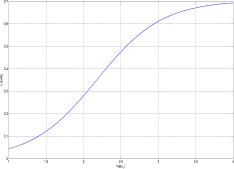
15
Problem 1-16 L = µ0N 2Ac g + lc/µr Problem 1-17 Part (a): µ0N 2Ac g+ lc/µr = 36.6 mH Part (b): µ0N 2 g +lc/µr I = 0.77 T λ = LI =4 40 × 10 2 Wb Problem 1-18 Part (a): With ω = 120π L = B =
Part (b): Using L from the solution to Problem 1-17
16 1 Vrms = ωNAcBpeak √ 2 = 20 8 V
√ 2Vrms Ipeak = = 1.66 A ωL Wpeak = 2 peak =9.13 × 10 2 J 2
1-19 B = 0.81 T and λ = 46.5 mWb
1-20 Part (a): R3 = q(R2 + R2) = 4.49 cm 1 2 Part (b): For lc = 4l + R2 + R3 2h; and Ag = πR2 µ0AgN 2 g+ (µ0/µ)lc = 61.8 mH Part (c): For Bpeak= 0.6 T and ω = 2π60 LI L =
Problem
Problem
17 λpeak = AgNBpeak ωλpeak Vrms = √ = 23 2 V 2 Irms = 1 Vrms ωL 1 = 0.99 A √ W = LI2 = L( 2I )2 = 61.0 mJ peak 2 peak 2 rms Part (d): For ω = 2π50 Vrms =19.3 V Irms = 0.99 A Wpeak = 61 0 mJ Problem 1-21 Part (a);

18
Part (b):
Emax = 4fNAcBpeak = 118 V

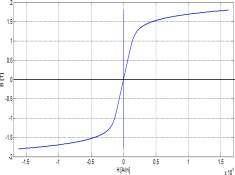
part (c): For µ = 1000µ0
Ipeak = lcBpeak µN = 0 46 A
Problem 1-22
Part (a);
Part (b): Ipeak = 0.6A
Part (c): Ipeak = 4.0 A
19
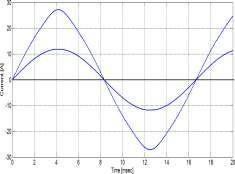
20
part (b), Ipeak = 11.9 A. For part (c), Ipeak = 27.2 A. Problem 1-24 L = µ0AcN 2 g + (µ0/µ)lc Bc = g µ0NI + (µ /µ)l 0 c Part (a): For I = 10 A, L = 23 mH and Bc = 1.7 T N = LI AcBc = 225 turns g = µ0NI µ0lc = 1.56 mm Bc µ Part (b): For I = 10 A and Bc = Bg = 1.7 T, from Eq. 3.21
Problem 1-23 For
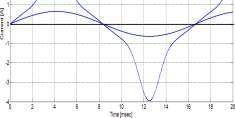
21
22 B c 2 Wcore = Vg = 0.072 J 2µ based upon Vcore = Aclc Vg = Acg Part (c): Wtot = Wg + Wcore = 1 15 J = 1 LI2 2 Problem 1-25 Lmin = 3.6 mH Lmax = 86.0 mH Problem 1-26 Part (a): N = LI BAc = 167 µ0NI g = 2BAc = 0 52mm Part (b): N = LI 2BAc = 84
23 g = µ0NI BAc = 0.52 mm
24 Problem 1-27 Part (a): N = LI BAc = 167 g = µ0NI (µ /µ)l = 0 39 mm 2BAc 0 c Part (b): N = LI 2BAc = 84 g = µ0NI (µ /µ)l = 0 39 mm BAc 0 c Problem 1-28 Part (a): N = 450 and g = 2 2 mm Part (b): N = 225 and g = 2.2 mm Problem 1-29 Part (a): µ0N 2A l = 11.3 H where L =
25 A = πa2 l = 2πr
26 Part (b): W = B2 7 2µ0 × Volume = 6.93 × 10 J where Volume = (πa2)(2πr) Part (c): For a flux density of 1.80 T, I = lB µ0N = 2πrB µ0N = 6.75 kA and ∆I 36 75 × 103 V = L ∆t =113 × 10 = 1.90 kV 40 Problem 1-30 Part (a): Copper cross sectional area ≡ Acu = fwab w w Copper volume = Volcu = fwb (a + )(h+ 2 2 ) wh Part (b): B = µ0JcuAcu g Part (c):
27 A Jcu = NI c u
28 cu = 2 2 Part (d): Pdiss= ρJ 2Volcu Part (e): Wstored = B2 2µ0 × gapvolume = µ0J 2 A2 wh cu cu 2g Part (f): and thus Wstore Pdiss L Wstored 1 I2L I R µ0A2 wh = 2 R Pdiss = cu gρVolcu Problem 1-31 Pdiss =6.20 W I = 155 mA N = 12, 019 turns R =258 Ω L = 32 H τ = 126 msec Wire size = 34 AWG Problem1-32 Part (a) (i): Bg1 = µ0N1 I1 g1 Bg2 = µ0N1 I1 g2 (ii)
29 λ1 = N1(A1Bg1 + A2Bg2) = µ0N2 A1 + A2 I1 1 g1 g2
30 λ = N A B = µ N N A2 I 2 22 g2 0 1 2 g2 1 Part (b) (i): Bg1 = 0 Bg2 = µ0N2 I2 g2 (ii) λ = N (A B + A B ) = µ N N A2 I 1 1 1 g1 2g2 0 1 2 g2 2 λ = N A B = µ N2 A2 I 2 22 g2 0 2 g2 2 Part (c) (i): Bg1 = µ0N1 I1 Bg2 = µ0N1 I1+ µ0N2 I2 g1 g2 g2 (ii) λ1 = N1(A1Bg1 + A2Bg2) = µ0N2 A1+ A2 I1 + µ0N1N2 A2 I2 1 g1 g2 g2 λ = N A B = µ N N A2 I + µ N2 A2 I 2 22 g2 0 1 2 g2 1 0 2 g2 2 Part (d): A1 A2 L µ N 2 A2 L1 = µ0N 2 + 1 g1 g2 20 2 2g
31 µA 1 L = µ N N A2 12 01 2 g2 Problem 1-33 g Rg = µ0Ac l1 R1 = µAc l2 R2 = µA lA RA = c c Part (a): L1 = N2 Rg+ R1 + R2 + RA/2 where R = RA LA = LB = N 2 R + RA(Rg + R1 + R2) RA + Rg + R1 + R2 Part (b): L = L = N1N 1B 1A 2(Rg+ R1 + R2 + RA/2) N2(Rg + R1 + R2)
32 L12 = 2RA (Rg+ R 1+ R )2+ R2A
33 Part (c): v (t) = L diA + L diB = L d(iA iB) 1 1A dt 1B dt 1A dt Problem 1-34 Part (a): µ0N1N2D(w x) L12 = 2g Part (b): v (t) = ωI µ0N1N2Dw cos ωt 2 o 4g Problem 1-35 Part (a): H = 2N1i1 (Ro + Ri) Part (b): v2(t) = N2w(n∆) dB(t) dt Part (c): v0(t) = GN2w(n∆)B(t)
Problem 1-36
Must have
For g = 0.05 cm and lc = 30 cm, must have µ > 0.014. This is satisfied over the approximate range 0 65 T ≤ B ≤ 1 65 T.
Problem 1-37
Part (a): See Problem 1-35. For the given dimensions, Vpeak= 20 V, Bpeak = 1 T and ω = 100π rad/sec N1 = Vpeak = 79 turns ω(Ro Ri)(n∆)
Part (b): (i) B = V0,peak = 0.83 T peak GN2(R0 Ri)(n∆)
(ii) Vpeak = ωN1(Ro Ri)(n∆)Bpeak= 9 26 V
Problem 1-38
Part (a): From the M-5 dc-magnetization characteristic, Hc = 19 A-turns/m at Bc =
34 H
µ0 lc < 0.
+ µ µ0 lc µ ⇒ µ = B > 19µ0 lc
05 g
Bg = 1.3 T. For Hg = 1.3 T/µ0 = 1.03 × 10
A-turns/m I = Hc
lA
lC
)
H
=
.2 A N1
6
(
+
g
+
gg
30
g

35 B 2µ Part(b): Wgap = gAC B g 2 2µ0 = 3 77 J For µ = Bc/Hc = 0.0684 H/m 2 Wc = (lAAA + lBAB + (lC g)AC) c = 4.37 × 10 3 J L = 2(Wgap+ Wc) = 8 26 mH I2 Part (c): Problem 1-39 Part (a): 2Wgap L = I2 = 8.25 mH Part (b): Loop area = 191 J/m3 Part (c):
36 Core loss = f × Loop area ρ
For f = 60 Hz, ρ = 7 65 × 103 kg/m3 , Core loss = 1.50 W/kg
Problem 1-40
Brms = 1.1 T and f = 60 Hz, Vrms = ωNAcBrms = 86 7 V
Core volume = Aclc= 1.54 × 10 3 m3. Mass density = 7.65 × 103 kg/m3. Thus, the core mass = (1.54 × 10 3)(7.65 × 103 ) = 11.8kg.
At B = 1.1 T rms = 1.56 T peak, core loss density = 1.3 W/kg and rms VA density is 2.0 VA/kg. Thus, the core loss = 1 3 × 11 8 = 15 3 W. The tota√ l exciting VA for the core is 2 0 ×11 8 = 23 6 VA. Thus, its reactive component is given by 23 62 15 32 =17 9VAR.
The rms energy storage in the air gap is
0 =5 08 J
corresponding to an rms reactive power of VARgap = ωWgap = 1917 VAR
Thus, the total rms exciting VAfor the magnetic circuit is VArms = q 15 32+(1917+17 9)2 =1935 VA
and the rms current is Irms = VArms/Vrms = 22.3 A.
Problem 1-41
Part(a): Area increases by a factor of 4. Thus the voltage increases by a factor of 4 to e = 1096 cos(377t).
37
c
µ
Wgap = gA
B2 rms
Part (b): lc doubles therefore so does the current. Thus I = 0.26 A.
Part (c): Volume increases by a factor of 8 and voltage increases by a factor of 4. There I
rmsdoubles to 0.20 A.
Part (d): Volume increases by a factor of 8 as does the core loss. Thus Pc = 128 W.
Problem 1-42
From Fig. 1.19, the maximum energy product for samarium-cobalt occurs at (approximately) B = 0 47 T and H = -360 kA/m. Thus the maximum energy product is 1 69×105
is a reduction by a factor of 5.09/1.21 = 4.9.
Problem 1-43
FromFig. 1.19, themaximum energy product for neodymium-iron-boron occurs at (approximately) B = 0.63 T and H = -470 kA/m. Thus the maximum energy product is 2.90 × 105J/m3 . Thus,
38
φ,
J/m3 . Thus, Am = 0.8 0 47 2 cm2 = 3.40 cm2 and l = 0.2 cm ! 0.8 = 0 35 cm m µ0( 360 × 105 )
the volume
3.40 × 0.35 = 1.20 cm3 ,
Thus
is
which
Am = 0 8 0.63 2 cm2 = 2.54 cm2
39 and
Thus the volumeis 2.54×0.25 = 0.688 cm3, which is a reduction by a factor of 5.09/0.688 = 7.4.
Problem 1-44
From Fig. 1.19, the maximum energy product for samarium-cobalt occurs at (approximately) B = 0.47 T and H = -360 kA/m. Thus the maximum energy product is 1.69 × 105
3 Thus, we want Bg = 1 3
Problem 1-45
From Fig. 1.19, the maximum energy product for samarium-cobalt occurs at (approximately) B = 0.63 T and H = -482 kA/m. Thus the maximum energy product is 3.03 × 105 J/m3 Thus, we want Bg = 1.3 T, Bm = 0.47 T and Hm = 360 kA/m.
40 H H lm = 0.2cm ! 0 8 µ0( 4.70 × 105) = 0.27 cm
J/m
Bm
0 47 T and Hm =
kA/m. ! hm = g Hg = g µ Bg = 2.87 mm m 0 m Am = Ag Bg Bm =2πRh Bg Bm = 45.1 cm2 Rm = s Am = 3 66 cm π
T,
=
360
! Hg h
Hm = g Bg µ0Hm = 2
m = g
15 mm
41 Am = Ag Bg Bm =2πRh Bg Bm = 31 3 cm2
For Bm= µR(Hm Hc), the maximum value of the product BmHmoccurs at Hm= Hc/2 and the value is B2/ r4µR
Problem 1-47
FromFig. 1.19, the maximum energy product for neodymium-iron-boron occurs at (approximately) Bm = 0.63 T and Hm = -470 kA/m. Themagnetization curve for neodymiumiron-boron can be represented as
where Br = 1 26 T and µR = 1 067µ0. The magnetic circuit must satisfy
part (a): For i = 0 and Bg= 0.6 T, the minimum magnet volume will occur when the magnet is operating at the maximum energy point.
42
1-46 Rm = s Am = 3.16 cm π
Problem
T [C] 3 (BmHm)max [kJ/m ] Corresponding Hm [kA/m] Bm[T ] 20 253.0 -440.0 0.57 60 235.7 -424.7 0.56 80 223.1 -413.2 0.54 150 187.5 -378.8 0.50 180 169.0 -359.6 0.47 210 151.5 -340.5 0.45
Bm = µRHm + Br
Hmd + Hgg = Ni; BmAm = BgAg
Am = Bg Ag = 6.67 cm2 Bm Hg d = Hm
43 g = 3 47 mm
part (b): Want Bg = 0.8 T when i = Ipeak
Because the neodymium-iron-boron magnet is essentially linear over the operating range of this problem, the system is linear and hence a sinusoidal flux variation will correspond to a sinusoidal current variation.
Problem 1-48
Part(a): Fromthesolution to Problem 1-46, themaximumenergyproductforneodymiumiron-boron at 180 C occurs at (approximately) Bm = 0.47 T and Hm = -360 kA/m. The magnetization curve for neodymium-iron-boron can be represented as
where Br = 0.94 T and µR = 1.04µ0. The magnetic circuit must satisfy
For Bg= 0.8 T, the minimum magnet volume will occur when the magnet is operating at the maximum energy point.
Part(b): At 60 C, Br = 1.12 T. Combining
44
h Bg dAg + g i Brd Ipeak = µRAm N µ0 µR = 6.37 A
Bm = µRHm + Br
Hmd + Hgg = 0; BmAm = BgAg
Am = Bg Bm Ag = 15.3 cm2 Hg d = Hm g = 5.66 mm
Bm = µRHm + Br










